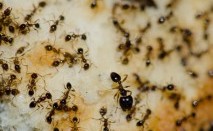
Category: Invertebrates
Crinoids, aptly nicknamed “feather stars”, can inhabit a wide range of marine environments and, judging by the fossil record, were very abundant organisms in the past, especially in the mid- to late-Paleozoic. They usually have a stem to attach themselves to a substrate but many only live attached as juveniles and spend most of their lives as free-swimming entities. They obtain nutrition by filtering small particles of food from the water using the mucous covered tube feet covering their feathery arms. Though they display the five-fold symmetry typical of echinoderms, some crinoids can have as many as two hundred arms!

It’s an ant’s world. We’re just living in it.
Do humans truly dominate the world? The Argentine ant may have something to say about that. Many ants are known for their large colonies, but the Argentine ant, named for its South American origins takes this to a whole other level. Due to inadvertent introduction by humans, the Argentine ant has spread to all continents except Antarctica. There are now three known super-colonies of these ants: one in Europe (the largest, covering 3,700 miles), one in California (560 miles), and another on the west coast of Japan. Ants are often territorial, but amazingly, ants belonging to the super-colonies recognize one another: if you were to introduce a super colony ant from Japan to one from Europe or California, they will recognize each other as friends!
Learn more >>
 Discover Animals is a web-based educational resource offered by the NAIA
Discover Animals is a web-based educational resource offered by the NAIA